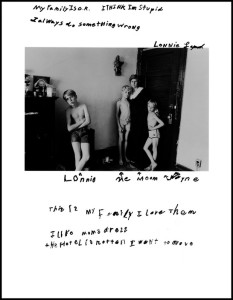In Goldberg’s portfolio of The Rich and The Poor, he photographs both wealthy and impoverished subjects in the late 70s and mid-80s. On each photograph is text that is hand-written by the subject, describing how the photograph makes them feel. This portfolio is such an intimate and challenging way to understand how ‘the other half lives’. Being that the majority of Americans are middle class, we cannot understand the struggle of those who have ten dollars to their name, nor the experiences of those who have so much money they don’t know what to do with it. Goldberg approaches this subject fearlessly, and his results are astounding.
“We look like ordinary people. We have a terrible life,” one woman writes next to a photograph of her and her baby daughter. A young looking boy writes, “It’s kind of stinky living in this hotel. I don’t have nothing only $10. I keep waiting for someone to come in my door and give me money but nobody ever will.” These beautifully composed images tell stories not only with the facial expressions, but with the surrounding environment and the text. You can tell which individuals are rich, and which live in poverty. The facial expressions and homes are all intimate clues to help the viewer understand the kind of life each subject is living.
This work really speaks to me because I grew up in a town full of privileged white people, and have never been exposed to extreme poverty except during my travels. I have seen extreme poverty in China, Thailand, Mexico, Turkey and Indonesia and I won’t forget my encounters with homeless children begging on the streets and the shacks built out of scrap metal on the side of the highway. I remember, when I was a child, I was terrified of homeless people. Every time I walked past a beggar on the street, I would run to my parents’ side and distance myself as far away from the beggar as I could. The reason that I was so terrified was because I knew absolutely nothing about them, and as human beings, we are all instinctually scared of what we don’t know. Goldberg does an amazing job of portraying the poor as people, which is not how society often looks at them. His work is presented in a way that makes the viewer see the subjects in an understanding, simplistic and accepting light. Through the facial expressions and text, Goldberg sends out a message that even though people in poverty live different lives then us, they value the same things. They care about their families, and their relationships. They fall in love, get married and have dreams. They also struggle with things like sexuality, depression and adolescence.
This work was also important for me to look at because I have been attempting to explore a way to get my viewers to instinctively refrain from judging my work, which has been an ongoing challenge for the past two years. After looking at Goldberg, I think that incorporating some text along with my images would be really important. Moreover, in Goldberg’s images, there is a lack of prop usage which helps prevent judgement, so I am going to explore taking photographs without props.
In conclusion, this work is powerful because it doesn’t shame the poor, or judge the rich. It simply introduces us to them in the intimate corners of their life in an incredibly simplistic way, leaving no room for judgement and only for understanding, sympathy and acceptance.

I looked over some of the photographs on the page to which you linked. The contrast between the pictures of the rich and poor is striking. The images of the poor living in inhospitable conditions are deeply moving. On the other hand, the pictures of the rich tell an entirely different story. One photo depicts an elderly man living in an extravagant home with his wife. I nearly burst out laughing when I read the beginning of the caption in which the man wrote, “My wife is acceptable. Our relationship is satisfactory.” It doesn’t sound like they have a very loving relationship.
We learned about this photographer in a class I took, and I totally agree with you. The words that a little boy is saying make such a huge impact, and it is easy to connect with people when you understand what is going through their head. I love descriptions with pictures, and I think this one is both strong and sad.